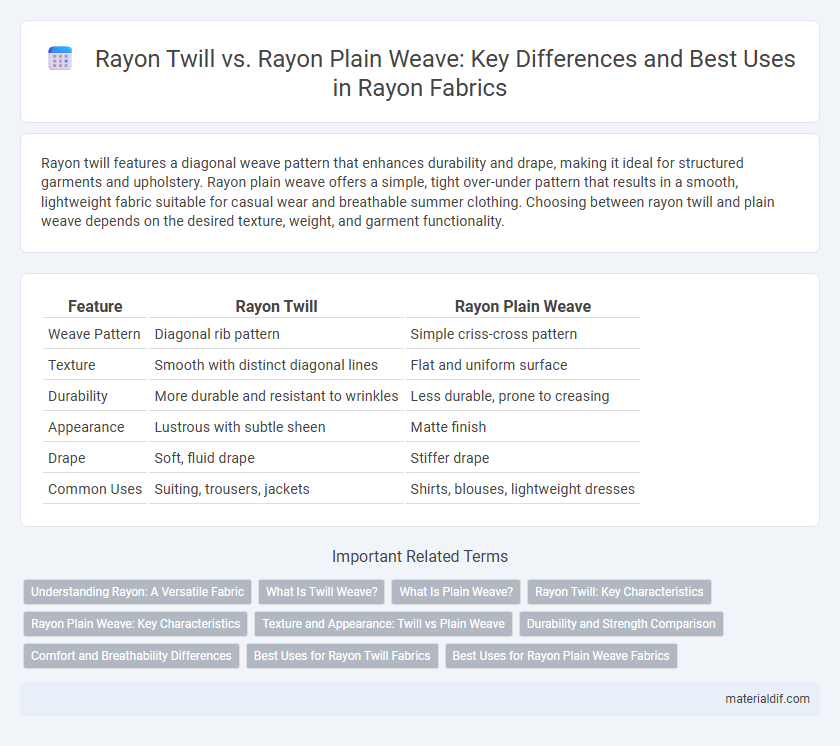Rayon twill features a diagonal weave pattern that enhances durability and drape, making it ideal for structured garments and upholstery. Rayon plain weave offers a simple, tight over-under pattern that results in a smooth, lightweight fabric suitable for casual wear and breathable summer clothing. Choosing between rayon twill and plain weave depends on the desired texture, weight, and garment functionality.
Table of Comparison
| Feature | Rayon Twill | Rayon Plain Weave |
|---|---|---|
| Weave Pattern | Diagonal rib pattern | Simple criss-cross pattern |
| Texture | Smooth with distinct diagonal lines | Flat and uniform surface |
| Durability | More durable and resistant to wrinkles | Less durable, prone to creasing |
| Appearance | Lustrous with subtle sheen | Matte finish |
| Drape | Soft, fluid drape | Stiffer drape |
| Common Uses | Suiting, trousers, jackets | Shirts, blouses, lightweight dresses |
Understanding Rayon: A Versatile Fabric
Rayon twill features a distinctive diagonal weave that enhances durability and drape, making it ideal for tailored garments requiring structure and fluidity. Rayon plain weave, characterized by its simple crisscross pattern, offers a smooth, lightweight texture suited for breathable, everyday clothing. Both weaves leverage rayon's inherent softness and moisture-wicking properties, underscoring its versatility across fashion and interior design applications.
What Is Twill Weave?
Twill weave is characterized by its distinctive diagonal rib pattern, created by weaving weft threads over one or more warp threads and then under two or more warp threads in a repeated sequence. This structure gives Rayon Twill enhanced durability, drape, and texture compared to the smoother, more uniform surface of Rayon Plain Weave. The diagonal lines in Rayon Twill provide added strength and resistance to wrinkles, making it a preferred choice for garments requiring both comfort and resilience.
What Is Plain Weave?
Plain weave is the simplest and most common textile weave, characterized by a crisscross pattern where the weft thread alternates over and under each warp thread. In rayon fabrics, plain weave creates a smooth, durable surface with balanced strength and minimal stretch, making it ideal for lightweight garments. Compared to rayon twill, plain weave offers a tighter, more uniform texture without the diagonal ribs typical of twill weaves.
Rayon Twill: Key Characteristics
Rayon Twill features a distinctive diagonal ribbing pattern that enhances fabric durability and provides a soft, smooth texture ideal for garments requiring structure and drape. Its weave allows for greater flexibility and resilience compared to Rayon Plain Weave, making it suitable for tailored clothing and upholstery. The twill construction also improves wrinkle resistance and adds a subtle sheen, elevating the fabric's aesthetic appeal.
Rayon Plain Weave: Key Characteristics
Rayon Plain Weave features a simple over-under weaving pattern, providing a smooth and even texture that enhances the fabric's breathability and softness. This weave offers greater durability and resistance to wear compared to twill, making it ideal for lightweight garments and linings. Its uniform surface also allows for vibrant dye absorption, resulting in rich, consistent colors suitable for diverse fashion applications.
Texture and Appearance: Twill vs Plain Weave
Rayon twill features a distinctive diagonal rib pattern that enhances fabric durability and adds a textured appearance, making it visually dynamic and suitable for structured garments. Rayon plain weave offers a smooth, flat surface with a consistent texture that provides a sleek, polished look ideal for flowing and lightweight apparel. The twill weave's texture catches light differently, creating subtle shadows, whereas plain weave's uniformity results in an even and matte finish.
Durability and Strength Comparison
Rayon twill features a diagonal weave pattern that enhances its durability and strength compared to rayon plain weave, which has a simpler over-under pattern. The twill construction provides greater resistance to wear and tear, making it more suitable for garments requiring sturdier fabric performance. In contrast, rayon plain weave is lighter and less resistant to abrasion, resulting in reduced longevity under frequent use.
Comfort and Breathability Differences
Rayon twill features a diagonal weave pattern that provides a slightly heavier and more durable fabric, enhancing comfort in cooler climates by retaining warmth while still allowing breathability. Rayon plain weave offers a smoother, lighter texture with a balanced over-under pattern, maximizing airflow and making it ideal for hot, humid conditions due to its superior breathability and moisture-wicking properties. The distinct weave structures directly impact comfort levels, with twill favoring structured durability and plain weave prioritizing lightweight ventilation.
Best Uses for Rayon Twill Fabrics
Rayon twill fabrics feature a distinctive diagonal weave that provides enhanced durability and a smooth drape, making them ideal for tailored garments like trousers, blazers, and outerwear where structure and elegance are essential. This weave also offers greater resistance to wrinkles compared to rayon plain weave, lending itself well to workwear and fashion pieces that require both comfort and a polished appearance. The heavier weight and tensile strength of rayon twill make it a preferred choice for stylish yet practical everyday apparel and upholstery applications.
Best Uses for Rayon Plain Weave Fabrics
Rayon plain weave fabrics offer a smooth, lightweight texture ideal for breathable summer wear, linings, and casual shirts, providing excellent drape and comfort. Its simple weave structure enhances durability and ease of maintenance, making it suitable for everyday apparel and home textiles such as curtains and pillowcases. Rayon plain weave's versatility also supports vibrant dye absorption, perfect for fashion designs requiring bright, lasting colors.
Rayon Twill vs Rayon Plain Weave Infographic

 materialdif.com
materialdif.com